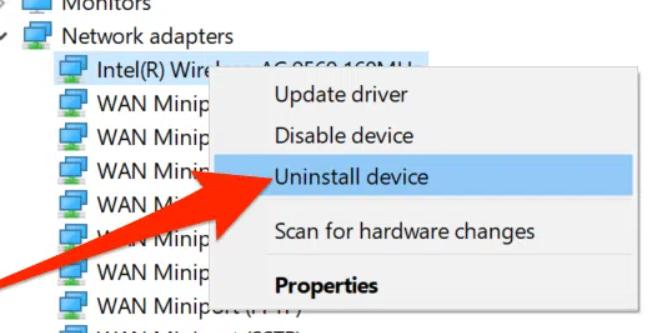Are you getting the Windows 10 cannot connect to this network error?
You are not alone. This is a common error reported by many users. So, what causes it? Well, there is no one fixed answer. The error can occur because of a number of reasons. All the same, it usually doesn’t take much to fix it.
In this post, we have discussed several solutions to this problem. You don’t have to try each and every solution; instead, start with the first one in the list and work your way down until the issue is fixed.
Solution One – Forget the network and reconnect to the network
Forgetting a network is helpful when you are facing problems connecting to a network. It erases all network settings saved by your computer. You have to enter credentials of the network to connect again. Here are the steps to follow.
- Go to system tray and right-click in network icon
- Click Open Network & Internet settings
- In the left-side bar, click on Wi-Fi to see your wireless adapters
- Next click on Manage known networks
- In the next screen, click on the problematic Wi-Fi network and click Forget
- The Wi-Fi network will be removed from known networks
- To reconnect to the network, scan networks like you normally do and click Connect
- Enter password when prompted
Solution Two- Toggle the Airplane Mode On & Off
This trick is used by smartphone users when they face network connectivity issues on their devices. This trick might also work on Windows 10. When you turn On the Airplane Mode in Windows 10, the device will disconnect from all networks. When you turn off the Airplane mode, you have to connect to the available networks.
- Go to system tray and click the network icon
- Click Airplane Mode to activate. The tile will turn blue which indicates Airplane Mode is ON
- Wait for some time
- Click Airplane Mode to deactivate. The tile will turn grey which indicates the Airplane Mode is Off.
- Now try connecting to the network. If you are still getting “Windows 10 cannot connect to this network” go to next solution.
Solution Three – Run Network Troubleshooter
Windows 10 features an in-built network troubleshooter. It can fix any underlying problems related to network connectivity. Here are the steps to run network troubleshooter.
- Click Start -> Settings (wrench icon)
- In the Settings screen, click Update and Security
- In the left side bar, click Troubleshoot
- In the right hand section, find and click additional troubleshooters
- In the next screen, click Internet connections -> Run the troubleshooter
- Wait for the troubleshooter to complete operation.
Solution Four – Disable IPv6 on your PC
Many computers work just fine with IPv4 and they don’t need IPv6 to connect to the Internet. Many users were able to resolve the “Windows 10 cannot connect to this network” error by disabling IPv6 and it could help you too. Here are the steps to follow.
- Go to system tray and right-click network icon
- In the network settings screen, click change adapter options under Advanced Network settings
- In the next screen, you will see icons of different network adapters. Right-click on problematic Internet adapter and select Properties
- In the Properties window, look for Internet Protocol version 6 (IPv6) and uncheck the corresponding box. This will prevent computer from using IPv6
Solution Five – Reset your network settings
Sometimes improper configuration of the network can also lead to errors like “Windows 10 cannot connect to this network”. Resetting network settings will set things right that may resolve the error. Here are the steps to follow.
- Open Settings
- Click Network and Internet
- Click Status in the left side bar
- Scroll down the window and click Network Reset option
- In the next screen, click Reset now
Solution Six – Run network command in Command Prompt
The “Windows 10 cannot connect to this network” could be due to wrong IP settings. Windows offers a few networking commands that can fix this problem. Here are the steps to follow.
- Click Start and type cmd in search bar
- In the search results, right-click Command prompt and select Run as administrator
- In the command window prompt, type the following command one after another. Press enter after typing command and wait for the command process to complete. Then type next command in the list
- netsh winsock reset
- netsh int ip reset
- ipconfig /release
- ipconfig /renew
- ipconfig /flushdns
After you have run all networking commands, reboot PC and try connecting to network.
Solution Seven – Modify network adapter settings
Many users were able to resolve the error by disabling 802.11d. Here are the steps to follow.
- Press Windows logo key and X simultaneously on your keyboard
- Click Settings from the menu
- Select Network and Internet
- In the right hand pane, click Change adapter options
- Locate your wireless adapter and right-click it.
- Select Properties from the menu
- In the Wi-Fi properties window, click Configure button
- Click Advanced tab
- From the Property list box, select 802.11d
- From the value drop down list, select Enabled
- Click OK to save changes
Solution Eight – Check the connection security type used by router and computer
The router offers security types like PA2-PSK (AES) or WPA-PSK (AES) to protect your wireless data. Both router and computer should use same connection security type. “The Windows 10 cannot connect to this network error”could be due to different connection security type used by router and computer
- Access router interface and check wireless settings. Note down the connection security type
- Right-click network connection in the system tray
- Select Open Network & Internet settings.
- Select Network and Sharing Center
- In the next window, click wireless network icon
- Next, click wireless properties
- In the properties window, go to Security tab
- Check the connection security type. Make sure it matches the router.
Solution Nine – Disable 802.1 1n mode of your network adapter
802.11n uses MIMO (multiple input / multiple output) technology and a wider radio frequency channel. It is used to increase network reliability, increase wireless local area network speed, and extend wireless range. You can often resolve this error by disabling 802.1 1n mode in network adapter. Here are steps to follow.
- Click Start and type Device Manager in search bar
- Click Device Manager from the search results. This will open Device Manager
- In the Device Manager window, go to Network adapters and expand it
- Right-click on your network adapter and click Properties
- In the Properties window, go to Advanced tab
- In the property list box, click 802.11n Mode
- In the Value drop-down box, select Disabled
Solution Ten – Uninstall your network adapter
There is a possibility the Windows 10 cannot connect to this network error is related to drivers. In that case, you need to uninstall your network adapter and reboot your PC. After reboot, Windows will identify missing drivers for the network adapter. It will install right network adapter drivers automatically. Here are the steps to follow.
- Open Device Manager
- Go to Network adapters section and expand it
- Right-click your network adapter and click Uninstall
- After the network adapter is uninstalled, restart your PC
Solution Eleven – Update Network Adapter drivers
The problem could be related to outdated network adapter drivers. You can update drivers manually or use a Driver Update Tool to update network drivers automatically. Here we have shared both methods to update network adapter drivers
Update drivers manually
- Open Device Manager
- Go to Network Adapters, expand it and right-click your network adapter
- Click Update Software
- Click Browse my computer for driver software.
- Click Let me pick from a list of device drivers on my computer.
- Ensure the Show compatible hardware option is not checked.
- Find your network adapter manufacturer and select the driver you wish to install
- After installing the driver, restart your computer
Update Drivers Automatically
If you don’t want to spend your precious time updating drivers manually or lack the technical knowledge needed to work with Device Manager, we recommend you use a driver update utility.
The software will update your network and other outdated drivers and keep them up-to-date.
Step 1
Click here to Install and launch the app
Step 2
Scan all devices
Step 3
Install or update drivers automatically
Solution Twelve – Reset Router
In many cases, the problem lies in the router. If none of the above solutions work for you, the last resort is resetting the router. Refer to the router documentation to find out the steps to reset your router.










Leave a Reply